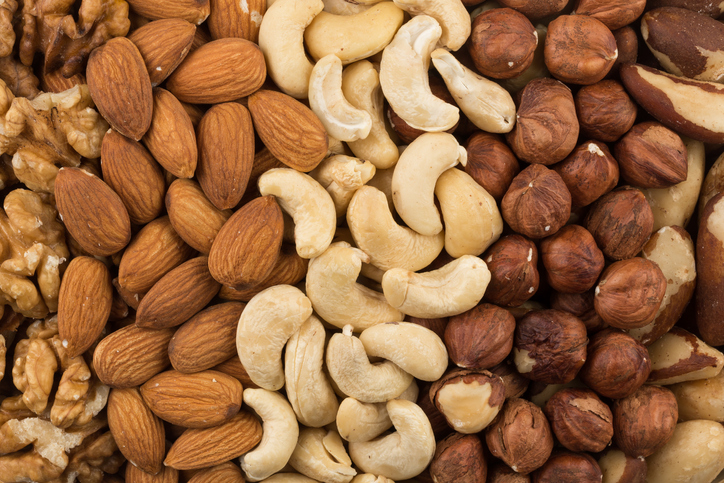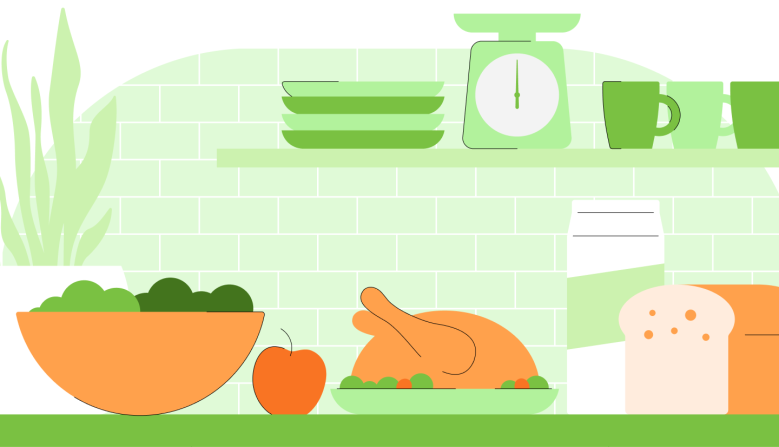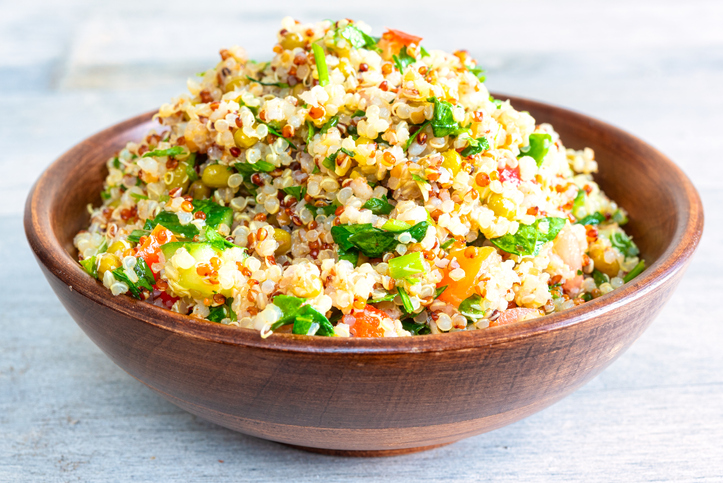Mediterranean Diet for Beginners: Everything You Need to Get Started



The Mediterranean diet may be the healthiest diet in the world. Rather than a strict meal plan, it’s a way of eating that emphasizes enjoying whole foods and regular physical activity. Here, we give you a blueprint to follow the Mediterranean diet—whether you want to make small changes or overhaul your entire way of eating.
What is the Mediterranean diet?
The Mediterranean diet is an eating pattern that follows the traditional way of eating in the countries surrounding the Mediterranean Sea. You don’t have to live in Italy, Spain or France to benefit from the diet, however; many people are transitioning to it for the range of health benefits it provides.
The Mediterranean diet isn’t a strict plan. Rather, it’s a way of eating that emphasizes fruits, vegetables, whole grains, legumes and olive oil. Fish is the main protein source instead of red meat, pork or poultry. And yes, it includes red wine—in moderation. Fermented dairy is consumed regularly but in moderate amounts. Eggs and poultry are occasionally consumed, but red meat and processed foods are not eaten regularly.
The Mediterranean diet is associated with lower cholesterol, reduced risk of heart disease and stroke, lower risk of Parkinson’s and Alzheimer’s diseases and a longer life. Emerging research shows it may also reduce risk of, and benefit those with, depression, anxiety, type 2 diabetes and some cancers.
How to get started with the Mediterranean diet
The idea is to mimic the healthy way of eating traditionally modeled by people in Mediterranean countries. Both the Mediterranean Diet Pyramid, which was developed by Oldways, and MyPlate, from the USDA, provide a general blueprint for what to eat at every meal. When in doubt, follow this simple rule of fractions: Make half your plate fruits and vegetables, one-quarter of your plate whole grains, and one-quarter of your plate healthy protein. Here are some more recommendations for how to fill those portions.
Focus on whole foods.
Processed foods are not a traditional part of the Mediterranean diet. If it comes in a package, check the ingredients list. Choose foods with just one to three whole-food ingredients, like bulgur or oats. Whole foods include fruits, vegetables, whole grains, nuts, legumes, fish and olive oil.
Make vegetables the main part of your meal.
Fruits and vegetables should make up the bulk of your meals. The Mediterranean diet emphasizes 7 to 10 servings of fruits and vegetables each day, but even 3 to 5 servings per day have been shown to reduce the risk of cardiovascular disease. Think of small ways you can add more vegetables to your meals, like adding spinach to your eggs, loading up your sandwich with avocado and cucumber, and having an apple with nut butter for a snack instead of crackers.
Swap red meat for fish.
Fatty fish like salmon, mackerel, tuna and herring are the main protein sources in the Mediterranean diet. These fish contain high amounts of omega-3 fatty acids, which reduce inflammation and improve cholesterol levels. White fish and shellfish are also good lean protein sources, but aren’t as high in omega-3s. Red and processed meats are eaten rarely. Chicken, turkey, eggs, cheese and yogurt can be enjoyed weekly or daily but in moderate portions.
Cook with olive oil instead of butter.
Olive oil is the main fat source in the Mediterranean diet. Total fat isn’t as important as the type of fat. The Mediterranean diet emphasizes eating more heart-healthy fats—poly- and monounsaturated fats—and fewer saturated and trans fats.
Saturated and trans fats raise LDL (“bad”) cholesterol. Swap butter for heart-healthy fats like olive oil to lower your cholesterol and improve your heart health.
Rethink your dairy.
America tends to be a cheese-on-everything society. Instead of dumping cheese on top of everything, aim to eat a variety of flavorful cheeses in moderation. Choose strong-flavored cheeses like feta or Parmesan (a smaller amount suffices) and skip processed ones, like American cheese.
Enjoy yogurt, too, but choose plain, fermented and Greek when possible. Skip the high-sugar, flavored yogurts; too much added sugar isn’t good for your health.
Replace refined grains with whole grains.
Swap white rice and pasta for whole grains like bulgur, barley and farro. Whole grains are a mainstay of the Mediterranean diet and boast a range of benefits, from lowering cholesterol to stabilizing blood sugars to weight loss. Whole grains are also high in B vitamins and fiber.
Beans and legumes have similar health benefits and are also a part of the Mediterranean diet.
Snack on nuts.
Don’t be scared of the fat in nuts. Like olive oil and avocados, nuts are high in poly- and monounsaturated fats—the healthy fats. They have protein and fiber too. Fat, protein and fiber are the perfect trio for staying full, keeping blood sugar stable, lowering cholesterol and reducing inflammation. Nosh on a quarter-cup of nuts between lunch and dinner. Walnuts have the most omega-3s, but all nuts contain healthy fats. Pair them with a fruit or vegetable if you need more to keep you full.
Skip the sugar (most of the time).
Processed cookies, crackers, refined flours and sugars are not a part of the Mediterranean diet and shouldn’t be eaten often. Save cookies and ice cream for special occasions. In the Mediterranean region, people indulge in treats like gelato and baklava in moderation. Otherwise, they eat fresh fruit, including dates and figs, to satisfy sugar cravings.
Enjoy red wine in moderation.
That’s about 5 ounces per day for women and 10 ounces per day for men. If you don’t currently drink, you don’t need to start drinking.
Mediterranean diet pantry list
Fruits & vegetables
Choose a variety of colors, and shop in season for optimal nutrients.
- Berries
- Apples
- Bananas
- Oranges
- Pears
- Clementines
- Cherries
- Grapes
- Avocado
- Apricots
- Figs
- Dates
- Tomatoes
- Potatoes
- Artichokes
- Greens (kale, spinach, collards, arugula)
- Cabbage
- Brussels sprouts
- Beets
- Onions
- Zucchini
- Peppers
- Peas
Whole grains
Mix and match for quick and easy sides, grain-bowl bases or simple grain stir-fries.
- Whole-grain breads
- Bulgur
- Buckwheat
- Farro
- Barley
- Couscous
- Oats
- Wheat berries
- Brown rice
Fish
Fish and other seafood are a cornerstone of the Mediterranean diet. Aim to eat more fish than other meat protein sources. Use Seafood Watch recommendations to help determine the best choices for the environment.
- Salmon, tuna, mackerel, herring and sardines
- Other seafood as desired
Poultry
These lean meats are welcome in the Mediterranean diet, but eat them less often.
- Chicken
- Turkey
Meat
Eat these protein-rich meats intermittently too. Combine a small portion with whole grains and vegetables for a balanced meal.
- Pork
- Beef
- Lamb (a few times per month or less)
Dairy
Dairy is welcome on the Mediterranean diet, in moderation.
- Unprocessed cheeses like feta, Brie, ricotta and Parmesan
- Plain yogurt and Greek yogurt
Nuts, seeds & legumes
Choose a variety as desired for snacks, salad toppers and more.
- Chickpeas and fava beans are typical in the Mediterranean region
- Walnuts, almonds, hazelnuts, cashews and pine nuts
- Sesame seeds
Herbs & spices
Instead of relying on the saltshaker, buy a variety of these to spice up your meals. Fresh herbs are delicious but dried herbs work too, just cut back on the amount.
- Parsley
- Garlic
- Mint
- Sage
- Rosemary
- Tarragon
- Basil
- Oregano
Other Mediterranean diet staples
- Olive oil, canola oil
- Eggs
- Red wine
© Meredith Operations Corporation. All rights reserved. Used with permission.

















